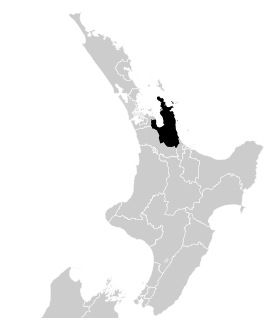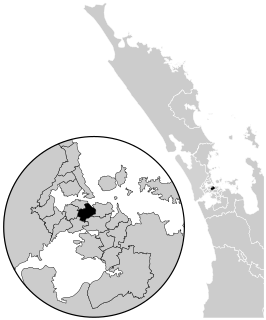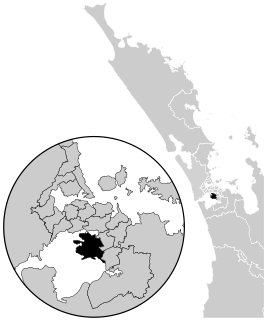
The 1996 New Zealand general election was held on 12 October 1996 to determine the composition of the 45th New Zealand Parliament. It was notable for being the first election to be held under the new mixed-member proportional (MMP) electoral system, and produced a parliament considerably more diverse than previous elections. It saw the National Party, led by Jim Bolger, retain its position in government, but only after protracted negotiations with the smaller New Zealand First party to form a coalition. New Zealand First's position as "kingmaker", able to place either of the two major parties into government, was a significant election outcome.

An electorate or electoral district is a geographical constituency used for electing members (MPs) to the New Zealand Parliament. The size of electorates is determined such that all electorates have approximately the same population.
Albany was a New Zealand electorate. It was located in north Auckland, and named after the suburb of Albany. It existed from 1978 to 1984, and then was reinstated in 1987 before its final abolition in 2002.
Aoraki was a New Zealand parliamentary electorate that existed for four parliamentary terms from 1996 to 2008. It was held by Jim Sutton of the Labour Party for three terms, and the remaining term by Jo Goodhew of the National Party. It was located in the South Island, covering southern Canterbury and northern Otago. It was named after the mountain Aoraki / Mount Cook.
Banks Peninsula is a New Zealand parliamentary electorate which initially existed from 1996 to 2008, and was later recreated in 2020 ahead of the 2020 election. It was held by National's David Carter for the initial term, and then by Labour's Ruth Dyson from 1999 to 2008. The seat is currently held by Labour's Tracey McLellan.

Coromandel is a New Zealand electoral division returning one member to the House of Representatives. It is currently represented by Scott Simpson, a member of the National Party.

East Coast is a New Zealand parliamentary electorate, returning one Member of Parliament to the New Zealand House of Representatives. The electorate first existed from 1871 to 1893, and was recreated in 1999. The current MP for East Coast is Kiri Allan of the Labour Party, who has held office since 2020.

Epsom is a New Zealand parliamentary electorate, returning one Member of Parliament to the New Zealand House of Representatives. As of the 2017 general election, its member of parliament is David Seymour.

Mana is a New Zealand parliamentary electorate north of Wellington. It has been held by Barbara Edmonds of the Labour Party since the 2020 election.

Māngere is a New Zealand parliamentary electorate, returning one member of parliament to the Representatives of New Zealand. The current MP for Māngere is William Sio, elected for the Labour Party. He has held this electorate since 2008.
Port Waikato is a New Zealand parliamentary electorate which existed for four parliamentary terms from 1996 to 2008, and was recreated by the 2019/20 electoral redistribution ahead of the 2020 election. It was held by Bill Birch for one term, and by Paul Hutchison for the following three terms; both were members of the National Party.

Te Tai Tokerau is a New Zealand parliamentary Māori electorate that was created out of the Northern Maori electorate ahead of the first Mixed Member Proportional (MMP) election in 1996. It was held first by Tau Henare representing New Zealand First for one term, and then Dover Samuels of the Labour Party for two terms. From 2005 to 2014, it was held by MP Hone Harawira. Initially a member of the Māori Party, Harawira resigned from both the party and then Parliament, causing the 2011 by-election. He was returned under the Mana Party banner in July 2011 and confirmed at the November 2011 general election. In the 2014 election, he was beaten by Labour's Kelvin Davis, ending the representation of the Mana Party in Parliament.
Waipareira was a New Zealand parliamentary electorate that existed for one parliamentary term from 1996 to 1999. Located in West Auckland, it was held by Brian Neeson of the New Zealand National Party, who had narrowly beaten Labour's Chris Carter.
Wayne Allan Kimber was a New Zealand politician of the National Party. He was born in Auckland in 1949.

The Hunua electorate existed three times for the New Zealand House of Representatives beginning in 1978, based at the south end of the Auckland urban area, and named for the Hunua Ranges. It covered different geographical areas over those periods. The electorate was last represented by Andrew Bayly of the National Party before its dissolution in 2020.
Karapiro was a New Zealand parliamentary electorate from 1996 to 2002.
Gisborne is a former New Zealand parliamentary electorate. It existed from 1908 to 1996, and it was represented by 12 Members of Parliament.
Owairaka was a New Zealand parliamentary electorate that existed for one parliamentary term from 1996 to 1999. Located in suburban Auckland, it was held by Helen Clark, who would become Prime Minister of New Zealand immediately after Owairaka was abolished.
East Cape is a former New Zealand Parliamentary electorate, from 1978 to 1993.
Ohariu-Belmont was a New Zealand parliamentary electorate from 1996 to 2008.








